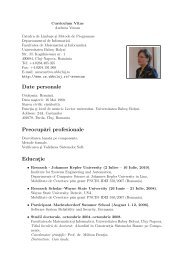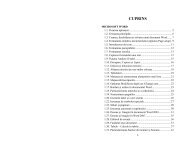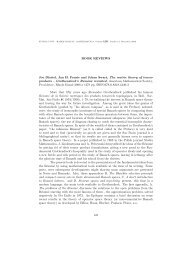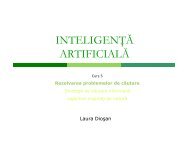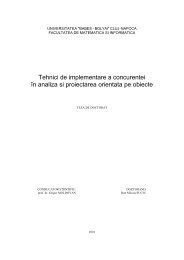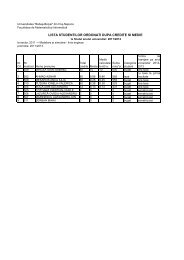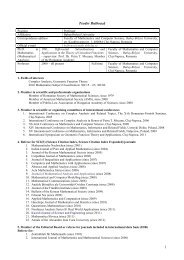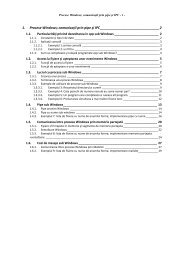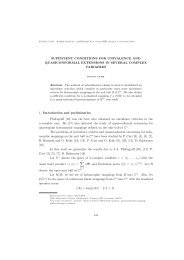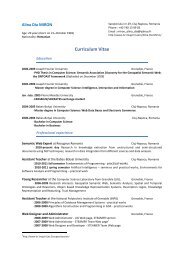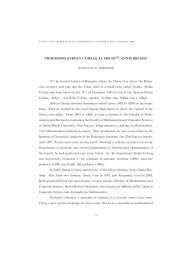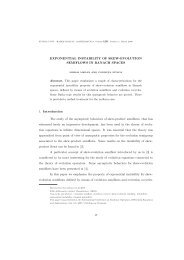CONTENTS
CONTENTS
CONTENTS
Create successful ePaper yourself
Turn your PDF publications into a flip-book with our unique Google optimized e-Paper software.
EFFICIENT RECURSIVE PARALLEL PROGRAMS FOR POLYNOMIAL INTERPOLATION 229<br />
new dimension. But, if a more complicated replication is used, Td depends on the<br />
particular replication function.<br />
3. Lagrange Interpolation<br />
The evaluation of the Lagrange polynomial in a given point x is an example of<br />
application where the set-distributions could be used with success. The input lists are:<br />
X = [x0, . . . , xm−1] distinct points; F = [f.x0, . . . , f.xm−1] function values. Because<br />
of the lack of space we will not present the entire derivation of the program.<br />
lagrange.X.F.x = red(+).(L.X.x ∗ F )<br />
L.X.x = U1.X.x/U2.X<br />
U1.X.x =< red(∗).(< x− > .X) / > .(< x− > .X)<br />
Function U2 computes the list of products formed by (xi − x0) . . . (xi − xi−1)(xi −<br />
xi+1) . . . (xi − xm−1), for any i : 0 ≤ i < m. Since in these calculations an element<br />
appears in computations more than once, the use of replication is appropriate.<br />
First, we consider a replication that is combined with a rotation function repR1.n.X.<br />
In this way, each column contains different elements, which means that each column<br />
contains the elements of list X in a different order.<br />
U2.X = UA.(repR1.n.X)<br />
UA.A = red1(∗).(dif.(first.A).A)<br />
The function UA is the most costing one, and we will refer to it in more detail.<br />
Distribution We define and use a Cartesian distribution distr ll .p0.p1, where p0, p1 <<br />
n and p0 +p1 = p. This means that 2 p0 ∗2 p1 = 2 p processors are available for working<br />
in parallel. In order to accept the distribution, the function UA is transformed:<br />
U2.X = UA p .(distr ll .p0.p1.(repR1.n.X))<br />
UA p .A = red p<br />
1 (∗).(dif p .(first.A).A)<br />
Time-complexity is O((p1 ∗ 2 n−p0 )α + 2 2n−p )<br />
Distribution costs In order to reduce the cost of data distribution, the number of<br />
distinct elements on each processor has to be as small as possible;<br />
θd(distr ll .p0.p1.A) = min{2 n , 2 n−p0 +2 m−p1 −1} But, this cost is very high, so we have<br />
to change the replication method. We can start from a distribution (one-dimensional<br />
distr.p0.X) of the list X, then to replicate this distributed list based on repR1.p0.·,<br />
and then to use replication based on repR1.(n − p0).· for each resulted sublist. After<br />
we apply the function flat we obtain a matrix B that has the property that each<br />
column is a different permutation of the list X, and we may apply the same function<br />
UA to compute the products u.xi.<br />
If we apply a Cartesian distribution distr ll .p1.p0, each resulted submatrix will<br />
have only 2 n−p0 distinct elements, if p1 ≥ p0, and 2 n−p0 × 2 p0−p1 distinct elements if<br />
p1 < p0. The analysis of the time-complexity and the distribution cost leads to the<br />
conclusion that the best decomposition of p is p = p0 + p1 = 2p0, p0 = p1, provided<br />
that p is even.



